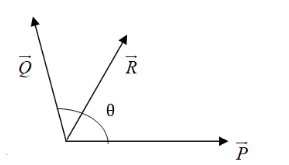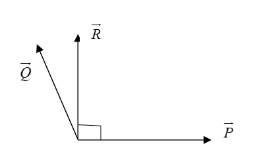
The resultant of two vectors $\overrightarrow P $ and $\overrightarrow Q $ is $\overrightarrow R $ .If the magnitude of $\overrightarrow Q $is doubled, the new resultant vector becomes perpendicular to$\overrightarrow P $ , then the magnitude of $\overrightarrow R $ is equal to
A. P+Q
B. P
C. P-Q
D. Q
Answer
546.9k+ views
Hint:A Vector quantity is the physical quantities which have both direction and magnitude. Thus, position vector is referred to as a straight line with one end fixed to the body and other end connected to a moving point and may be used to state the position of a point relative to the body. The displacement vector of a particle is the vector which joins its initial position to the final position. Other examples of vector quantities are force, displacement, velocity, etc.
Complete step by step answer:
$\overrightarrow P $, $\overrightarrow Q $are two vectors. According to question
$\overrightarrow R $is the resultant vector of $\overrightarrow P $ and $\overrightarrow Q $ as shown in the diagram (self made). It means the value of resultant vector ($\overrightarrow R $) is:
$\overrightarrow R $=$\overrightarrow P $+$\overrightarrow Q $

Since we are given that resultant of P and Q is R therefore magnitude of R is given by ${R^2} = {P^2} + {Q^2} + 2PQ\cos \theta $
Where, θ is the angle between $\overrightarrow P $ and $\overrightarrow Q $
If vector$\overrightarrow Q $ is doubled (i.e. 2$\overrightarrow Q $) then new resultant become $\overrightarrow {{R^1}} $ (shown in diagram (self-made)) i.e.:
$\overrightarrow {{R^1}} = \overrightarrow P + 2\overrightarrow Q $

As we know that if one vector is perpendicular to another vector then its dot product is zero so that we can say that:
$
\overrightarrow {{R^1}} *\overrightarrow {{P^{^1}}} = 0 \\
\Rightarrow \left( {\overrightarrow P + 2\overrightarrow Q } \right)*\overrightarrow P = 0 \\
\Rightarrow {P^2} + 2\overrightarrow Q \overrightarrow P = 0 \\
$
As a result:
$2\overrightarrow Q \overrightarrow P = - {P^2}$ [It should be noted that P is magnitude not the vector] (I)
We know that:
$R = \sqrt {{P^2} + {Q^2} + 2\overrightarrow P \overrightarrow Q } $ [Addition vector rule]
Now substituting the value from equation (i) we get:
\[
{R^2} = {P^2} + {Q^2} - {P^2} \\
\therefore {R^2} = {Q^2}
\]
This indicates that the magnitude of $\overrightarrow R $ is equal to the magnitude of $\overrightarrow Q $.
Hence, option D is correct.
Note: R and Q both are the magnitude of the vector in the present case so it must have positive value, can’t hold negative value (because angle between two vectors is acute). If the angle between the two vectors is obtuse, their dot product is negative. .Always remember that if one vector is perpendicular with another vector then its dot product is zero i.e. $\overrightarrow R *\overrightarrow P = 0$in the present case. On the other hand if one vector is parallel with another vector, then its dot product is always one.
Complete step by step answer:
$\overrightarrow P $, $\overrightarrow Q $are two vectors. According to question
$\overrightarrow R $is the resultant vector of $\overrightarrow P $ and $\overrightarrow Q $ as shown in the diagram (self made). It means the value of resultant vector ($\overrightarrow R $) is:
$\overrightarrow R $=$\overrightarrow P $+$\overrightarrow Q $

Since we are given that resultant of P and Q is R therefore magnitude of R is given by ${R^2} = {P^2} + {Q^2} + 2PQ\cos \theta $
Where, θ is the angle between $\overrightarrow P $ and $\overrightarrow Q $
If vector$\overrightarrow Q $ is doubled (i.e. 2$\overrightarrow Q $) then new resultant become $\overrightarrow {{R^1}} $ (shown in diagram (self-made)) i.e.:
$\overrightarrow {{R^1}} = \overrightarrow P + 2\overrightarrow Q $

As we know that if one vector is perpendicular to another vector then its dot product is zero so that we can say that:
$
\overrightarrow {{R^1}} *\overrightarrow {{P^{^1}}} = 0 \\
\Rightarrow \left( {\overrightarrow P + 2\overrightarrow Q } \right)*\overrightarrow P = 0 \\
\Rightarrow {P^2} + 2\overrightarrow Q \overrightarrow P = 0 \\
$
As a result:
$2\overrightarrow Q \overrightarrow P = - {P^2}$ [It should be noted that P is magnitude not the vector] (I)
We know that:
$R = \sqrt {{P^2} + {Q^2} + 2\overrightarrow P \overrightarrow Q } $ [Addition vector rule]
Now substituting the value from equation (i) we get:
\[
{R^2} = {P^2} + {Q^2} - {P^2} \\
\therefore {R^2} = {Q^2}
\]
This indicates that the magnitude of $\overrightarrow R $ is equal to the magnitude of $\overrightarrow Q $.
Hence, option D is correct.
Note: R and Q both are the magnitude of the vector in the present case so it must have positive value, can’t hold negative value (because angle between two vectors is acute). If the angle between the two vectors is obtuse, their dot product is negative. .Always remember that if one vector is perpendicular with another vector then its dot product is zero i.e. $\overrightarrow R *\overrightarrow P = 0$in the present case. On the other hand if one vector is parallel with another vector, then its dot product is always one.
Recently Updated Pages
Why are manures considered better than fertilizers class 11 biology CBSE

Find the coordinates of the midpoint of the line segment class 11 maths CBSE

Distinguish between static friction limiting friction class 11 physics CBSE

The Chairman of the constituent Assembly was A Jawaharlal class 11 social science CBSE

The first National Commission on Labour NCL submitted class 11 social science CBSE

Number of all subshell of n + l 7 is A 4 B 5 C 6 D class 11 chemistry CBSE

Trending doubts
What is meant by exothermic and endothermic reactions class 11 chemistry CBSE

10 examples of friction in our daily life

One Metric ton is equal to kg A 10000 B 1000 C 100 class 11 physics CBSE

1 Quintal is equal to a 110 kg b 10 kg c 100kg d 1000 class 11 physics CBSE

Difference Between Prokaryotic Cells and Eukaryotic Cells

What are Quantum numbers Explain the quantum number class 11 chemistry CBSE




